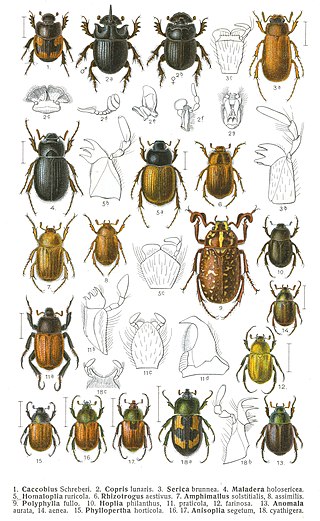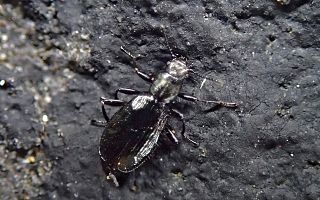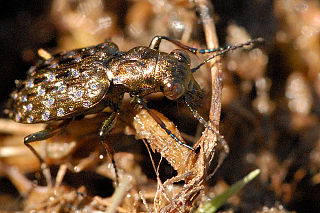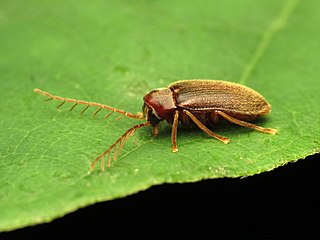
The family Scarabaeidae, as currently defined, consists of over 35,000 species of beetles worldwide; they are often called scarabs or scarab beetles. The classification of this family has undergone significant change in recent years. Several groups formerly treated as subfamilies have been elevated to family rank, and some reduced to lower ranks. The subfamilies listed in this article are in accordance with those in Catalog of Life (2023).

Ground beetles are a large, cosmopolitan family of beetles, the Carabidae, with more than 40,000 species worldwide, around 2,000 of which are found in North America and 2,700 in Europe. As of 2015, it is one of the 10 most species-rich animal families. They belong to the Adephaga. Members of the family are primarily carnivorous, but some members are herbivorous or omnivorous.

The Haliplidae are a family of water beetles that swim using an alternating motion of the legs. They are therefore clumsy in water, and prefer to get around by crawling. The family consists of about 200 species in 5 genera, distributed wherever there is freshwater habitat; it is the only extant member of superfamily Haliploidea. They are also known as crawling water beetles or haliplids.

The longhorn beetles (Cerambycidae), also known as long-horned or longicorns, are a large family of beetles, with over 35,000 species described.

Dynastinae or rhinoceros beetles are a subfamily of the scarab beetle family (Scarabaeidae). Other common names – some for particular groups of rhinoceros beetles – include Hercules beetles, unicorn beetles or horn beetles. Over 1,500 species and 225 genera of rhinoceros beetles are known.

The valley elderberry longhorn beetle is a subspecies of longhorn beetle native to the riparian forests of the Central Valley of California from Redding to Bakersfield. It is listed as a federally threatened species; a proposal to delist the insect was withdrawn in 2014.

Aegialites is a genus of narrow-waisted bark beetles in the family Salpingidae. There are about 13 described species in Aegialites.

The elderberry borer, Desmocerus palliatus, is a species of Cerambycidae that occurs in Eastern North America.

Elaphrus is a genus in the beetle family Carabidae. There are at least 40 described species in Elaphrus.
Desmocerus aureipennis is the species of the Lepturinae subfamily in long-horned beetle family. This species is distributed in United States and Canada.

Lebiinae is a subfamily of ground beetles in the family Carabidae. There are more than 330 genera and 6,300 described species in Lebiinae, in 5 tribes.

Desmocerus is a genus of beetles in the family Cerambycidae, containing the following species:

Insects have long been used in religion, both directly and as images or symbols.

Haeterius is a genus of clown beetles in the family Histeridae. There are at least 20 described species in Haeterius.
Hyporhagus gilensis is a species of opossum beetle in the family Zopheridae. It is found in North America.

Limonius is a genus of click beetles in the family Elateridae. Many of the species formerly placed in this genus have been removed to other genera such as Gambrinus.
Ptomaphagus is a genus of small carrion beetles in the family Leiodidae. There are at least 50 described species in Ptomaphagus.

Ptilodactylidae is a family of beetles belonging to the Elateriformia. There around 500 extant species in 35 genera. They are generally associated with riparian and aquatic habitats. The larvae generally live associated with rotting wood or vegetation, or within gravel and detritus on the edge of water bodies. The larvae of some species feed on submerged rotting wood or on plant roots, while the adults of some species are known to feed on fungus with modified brush-like maxillae.

Cypherotylus californicus, known commonly as the blue fungus beetle or blue pleasing fungus beetle, is a species of pleasing fungus beetle in the family Erotylidae. It is recorded from Wyoming, Colorado, New Mexico, Arizona, California, Kansas in the United States, and the Mexican state of Sonora. The elytra are blue with black dots, with the blue turning gray as they age. The adult beetles typically are about 1.4–1.8 cm (0.6–0.7 in) long.

Omus californicus, the California night-stalking tiger beetle, is a species of tiger beetle in the family Cicindelidae. It is found in North America.


















